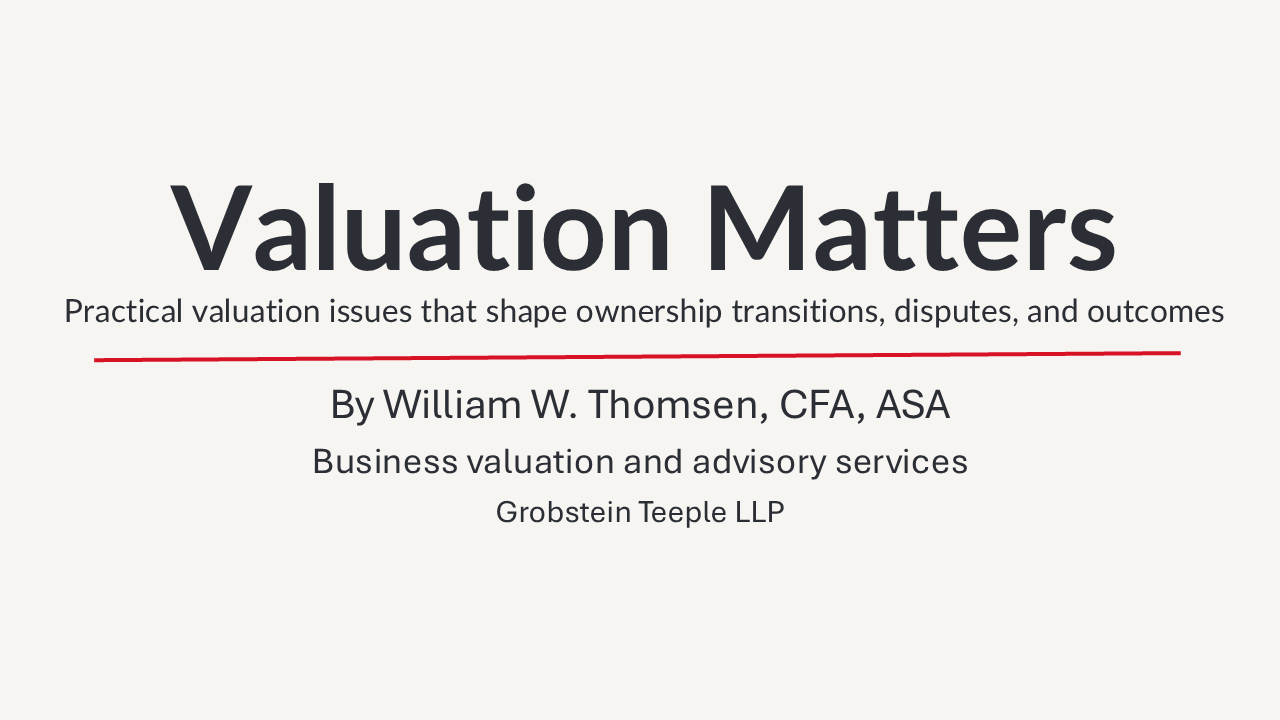Introduction

Welcome to Valuation Insights!
Our goal is to bring you key ideas and trends in business valuation -- so you and your clients can make decisions that get winning results.
Climate Risk and Valuation
With climate-related insurance losses topping $100 billion for four straight years, insurers are pulling out of high-risk markets and tightening claims scrutiny. We explore how forensic accountants and valuation experts are playing a critical role in quantifying damages, distinguishing covered vs. uncovered losses, and supporting litigation and audits in the wake of catastrophe.
Why ESG Matters More than Ever in Valuation
Think ESG is losing relevance? Think again. Despite political headwinds, investors and regulators are doubling down on material ESG issues that impact valuation and long-term performance. A mid-year update highlights how ESG is shifting from vague compliance to a source of competitive advantage.
Narcissists and Valuation
Financial disputes involving narcissists can derail resolution efforts and distort valuation outcomes. From gaslighting and hidden assets to frivolous filings and credibility attacks, this article outlines the red flags and offers strategies valuation experts and legal teams can use to stay focused, objective, and defensible.
Managing Earnouts in Mergers and Acquisitions
Earnouts can help close the gap in deal valuations—but they also frequently lead to post-deal litigation. Drawing on Delaware case law, we highlight seven key lessons for drafting clear, enforceable earnouts and outline alternative structures that reduce risk and preserve value.
Valuation Guidance from Pierce vs. Commissioner
In the Recent Pierce vs. Commissioner Tax Court ruling, the strength of valuation conclusions came down to one thing: supported, well-reasoned assumptions. This case recap underscores why valuation professionals must tie forecasts, discounts, and tax treatment to contemporaneous facts if they want their work to withstand scrutiny.
On to the issue!
Context & Observations

Narcissists and Valuation
A recent article examining financial manipulation in divorce cases highlights how narcissistic behaviors can complicate financial disputes.
Yet these insights can apply more broadly to shareholder conflicts, business dissolutions, and pretty much any transaction. Narcissists often use manipulation tactics that distort the financial picture and prolong conflict, making resolution especially challenging.
The article identifies several tactics employed by narcissists in financial disputes:
- Gaslighting – Distorting facts to make others question their own memory or judgment.
- Blame-shifting – Refusing accountability by placing responsibility on the other party.
- Projection – Accusing others of the very misconduct the narcissist is committing.
- Financial manipulation – Hiding assets, inflating expenses, or refusing to meet obligations.
- Obfuscation – Delaying or avoiding financial disclosures to frustrate proceedings.
- Smear campaigns – Undermining the other party’s credibility through false accusations or rumors.
- Playing the victim – Portraying themselves as unfairly treated to gain sympathy or influence perception.
- Shifting narratives – Frequently changing stories to create confusion and avoid accountability.
- Frivolous filings – Using lawsuits, motions, or hearings to delay proceedings and drain the other party financially and emotionally.
- Undermining experts – Attempting to discredit or manipulate valuation specialists and forensic accountants.
- Creating complex ownership structures – Establishing new entities or trusts to conceal true ownership
Takeaways when Narcissists are Involved in a Transaction or a Dispute
Valuation specialists need to:
- Stay objective and focused on facts, even amid incomplete data and shifting stories.
- Watch for tactics like hidden assets, delayed disclosures, and efforts to discredit or minimize relevancy of work.
- Deliver clear, reasonable, and well-supported analyses that stand up under scrutiny.
Attorneys, advisors, and business owners ought to:
- Recognize that financial disagreements may be fueled by underlying narcissistic control struggles.
- Bring valuation experts in early to uncover hidden information and counter delay tactics.
- Help clients focus on objective financial realities and long-term value, rather than emotional battles.
Financial transactions are rarely just about numbers — all involve complex dynamics of control, emotion, and strategy. Navigating situations involving narcissists requires a particularly strong partnership between legal and financial professionals.
What has been your experience with transactions or disputes involving narcissists?

The Art and Science of Earn-Outs in M&A
Earnouts in M&A: Value Bridge or Litigation Trap? A Closer Look at Delaware’s Evolving Guidance
In M&A deals—especially in early-stage or volatile sectors—earnouts can bridge gaps when buyers and sellers can’t agree on valuation. But as Vice Chancellor J. Travis Laster of the Delaware Chancery Court warned:
“An earn-out often converts today’s disagreement over price into tomorrow’s litigation over the outcome.”
Delaware courts have become key in shaping how earnouts are interpreted. For legal and valuation professionals, recent decisions offer essential guidance for drafting and dispute avoidance.
Why Use an Earnout?
- Resolve valuation gaps based on future performance.
- Align incentives and reduce upfront cash needs.
- Make deals possible in uncertain environments (e.g., tech, life sciences).
Still, the risk of dispute grows with larger, longer earnouts.
Earnout Risk Profile
As a rule:
- The larger the earnout vs. upfront price,
- And the longer the earnout period,
- The higher the litigation risk.
Delaware Chancery Court: 7 Key Lessons from Case Law
- Clearly Defined Milestones: Vague or subjective performance goals are vulnerable. Earnouts should rely on specific, measurable milestones.
- “Efforts” Obligations: If buyers aren’t contractually required to support the earnout, they have wide leeway—even if actions undermine it.
- “Commercially Reasonable Efforts” Standards: Outward-facing efforts (e.g., regulatory filings) are judged differently than internal conduct. Be clear which applies.
- Good Faith: Courts won’t impose implied duties where contracts are silent. Bad faith claims rarely survive without express terms.
- Acceleration of Earn-out Payments: Courts won’t accelerate earnouts unless the contract clearly allows it—even if buyers breach elsewhere.
- Expert Determination vs. Arbitration: Distinguish financial/accounting disputes from broader legal ones. Courts won’t reframe dispute resolution terms.
- Recordkeeping: Poor documentation can doom defenses. Buyers should maintain clean, auditable records tied to earnout metrics.
Potentially Smarter Alternatives to Earnouts:
- Escrows or holdbacks based on short-term results.
- Contingent seller notes with repayment tied to performance.
- Equity rollovers to align incentives.
- Contingent value rights (CVRs) for binary outcomes (e.g., FDA approval).
Valuation Experts: Critical in Earnout Disputes
Valuation specialists are often asked to:
- Model expected vs. actual performance.
- Quantify harm from alleged breaches.
- Assess whether buyer conduct materially impacted results.
Have you seen earnouts go smoothly—or sideways? What creative alternatives have worked well for your clients?
Practice Notes

Lessons from the Pierce Case: The Importance of Relevant Data and Reasoned Analysis
A recent tax court case reminds us that the supported assumptions and sound analysis that go into a model are what make it work and the conclusions persuasive.
In Pierce v. Commissioner (T.C. Memo 2025‑29), the Tax Court assessed the gift tax value of minority interests in Mothers Lounge, LLC, a fast-growing, debt-free S Corp selling baby products through online and retail channels. This company also engaged in questionable but lucrative policies -- like selling a product for "free" but massively overcharging on shipping costs.
The taxpayer’s 2014 valuations came under IRS scrutiny, as the taxpayer was accused of undervaluing the interests, and hence making gifts. Ultimately, this led to both sides -- taxpayer and IRS -- to present DCF-based valuations to the Court — but with differing forecasts, tax treatments, discount rate assumptions, and DLOC/DLOM adjustments, and significantly different value conclusions.
The Court ultimately blended inputs from both experts, siding with each on different issues when developing their own valuation. The deciding factor? Assumptions backed by relevant, contemporaneous data and clearly explained reasoning were persuasive.
Some Takeaways: Valuation Requires More Than a Model
- Use What’s Known—or Knowable—at the Valuation Date: The IRS appraiser got dinged by the Court for using a forecast that reflected post-value date information. Forecasts must reflect real-world facts as of the gift date.
- Tax-Affecting Is Allowed—If Supported: The Court accepted tax-affecting S Corp earnings when supported by a balanced, clearly articulated method accounting for pass-through benefits.
- Discount Rate Inputs Must Be Transparent: Risk premiums and cost of equity assumptions must be tied to evidence. Courts scrutinize company-specific adjustments especially closely.
- Support Discounts with Specifics: Discounts for lack of control and marketability (5% and ~25–30%) were upheld—but the Court accepts those that were tied to facts like operating agreements, cash flow, and shareholder restrictions.
Bottom Line
Pierce provides an informative case study that reinforces a simple truth: valuation credibility hinges on relevant data and sound reasoning. Whether you’re a valuation expert or tax advisor, this case is a reminder to build conclusions that are not only technically correct—but defensible and well-documented.
In Closing

If you found this issue of Valuation Insights useful, please forward it to a friend or colleague.
And if you have a valuation or damages-related issue you would like to discuss, or a topic you would like to see covered in a future issue, let me know! You can reach me one of the ways below.
Will
William W. Thomsen
Director
Grobstein Teeple, LLP www.gtllp.com
Ways to reach me:
- Connect with me on LinkedIn
- Call me at 818-502-4950
- Email me
- Schedule a one-on-one meeting

Commentary
Climate Risk, Insurance Losses & the Expanding Role of Forensic Experts
The U.S. property & casualty insurance industry is experiencing existential disruption.
Four consecutive years of natural catastrophe losses exceeding $100 billion have destabilized underwriting and strained reserves. Insurers are rapidly exiting high-risk markets like California and Florida. Premiums are rising—up 20% nationally from June 2022 to June 2023—and reinsurance capacity is tightening.
Many of these losses stem not from "headline" events like hurricanes, but increasingly from secondary perils: wildfires, hail, inland flooding, and extreme convective storms. These types of losses often elude traditional catastrophe models.
While insurers recalibrate risk models and policy pricing, another group is stepping forward to address the economic fallout from these events: forensic accountants and valuation analysts.
How Valuation Specialists and Forensic Accountants Can Help
Business Interruption & Lost Profits. We help quantify how a disaster affects operations and profitability—whether through facility shutdowns, supply chain failures, workforce displacement, or customer churn. This forms the basis of defensible business interruption and lost profits claims.
Diminution in Business Value. Where events cause lasting damage to a company’s ability to generate future income—through lost contracts, reputational harm, or reduced market share—we estimate the resulting impact on business value using established valuation methods.
Clear Separation of Covered vs. Uncovered Losses. Apportioning damages between insured and uninsured losses is essential for resolving claims without prolonged dispute. We analyze financial records, policy language, and event timelines to allocate costs clearly and fairly.
Support for Subrogation & Litigation. When insurers seek to recover losses from third parties (e.g., utility companies in wildfire cases), or when claims are denied or disputed, forensic and valuation experts provide the detailed, data-driven analysis necessary to support damage assessments in legal proceedings.
Post-Event Audits & Claim Reviews. Large claims increasingly trigger regulatory reviews or internal audits. Forensic accountants assist insurers in verifying claims, identifying potential overstatements or fraud, and ensuring appropriate reserve provisioning.
Bottom Line
Climate change isn’t just a modeling problem—it’s a measurement problem.
If you’re a litigator, claims manager, insurer, or business advisor navigating post-disaster claims or financial loss disputes, or work with any of the above, let’s talk. These challenges aren’t going away—and the need for credible economic analysis has never been greater.
quickreadbuzz.comESG Mid-Year Update -- Why Sustainability Still Matters to Valuation
Think that current political trends have rendered ESG (Environmental, Social, and Governance) considerations unimportant to business management and valuation? Think again.
A recent piece published on Harvard Law School's Forum on Corporate Governance provides the following key takeaway:
Investors, regulators, and issue-focused parties, who influence a company's market value, keep prioritizing ESG. By mid-2025, despite a perceived political pullback, the business case for ESG remains robust, indicating its enduring significance.
Investment Focus: ESG Is Sharpening, Not Shrinking
Regulatory Landscape: Disclosure Is Expanding Globally
ESG Pressure Points: Issue‑Focused Stakeholders Are Active
ESG: Evolving from Compliance to Competitive Advantage. The above trends present a massive opportunity for businesses to gain market share and competitive advantage. According to the authors, three themes encapsulate this opportunity:
Bottom line: ESG is evolving, not shrinking.
fticonsulting.com